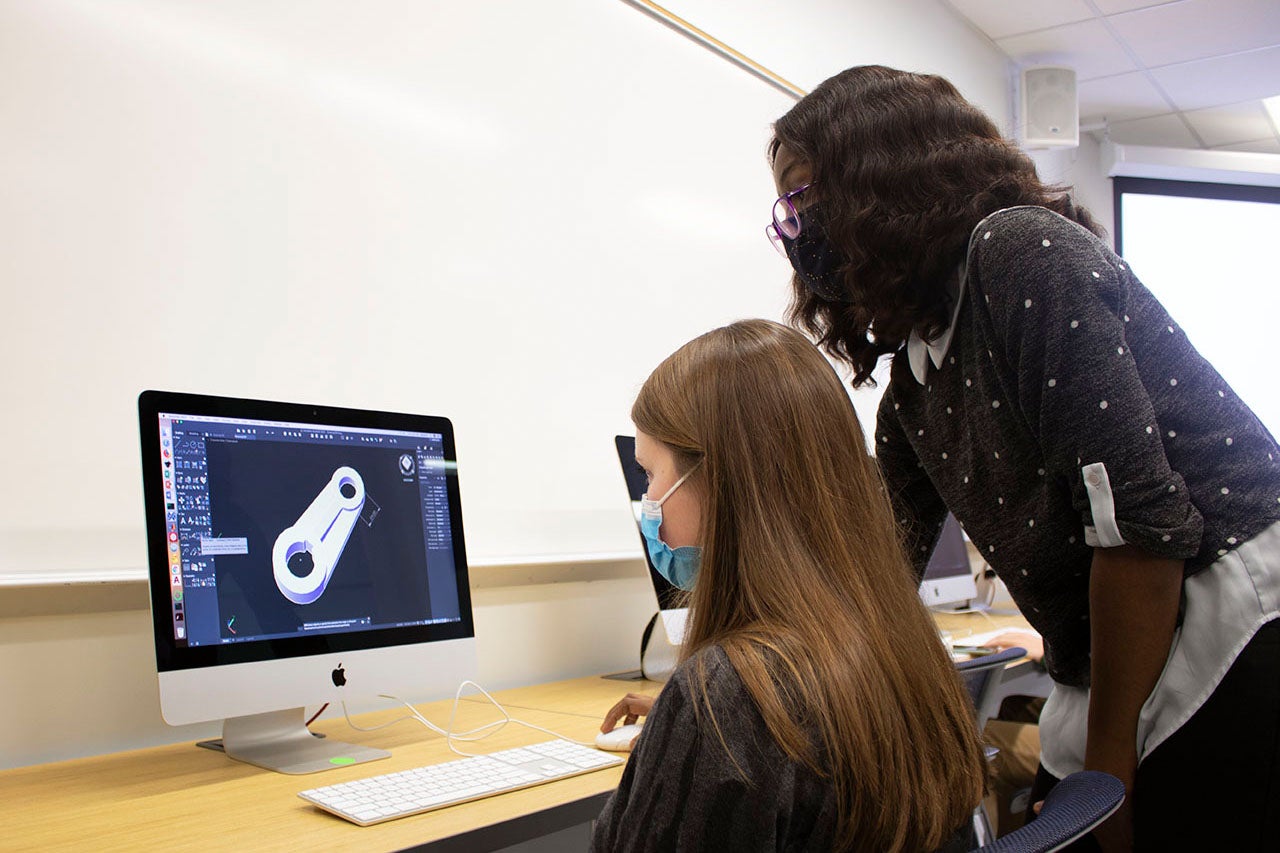Above: Engineering instructor Olufunke Oladimeji (right) assists systems engineering student Christy Charbonnet with CAD software.
Say the word engineering and most people conjure images of intricate plans, complicated structures or state-of-the-art devices. While those interpretations are valid, engineering is a rapidly evolving domain with ever-increasing applications.
Engineers work in the realm between scientific discovery and commercial application to address societal and consumer needs. And though there are nearly a dozen different specialties in this field (electrical, mechanical, civil, software, aerospace, etc.), one element links them all. That’s the need for engineers to operate in a visual space, using two-dimensional and three-dimensional depictions to design, explain and convey their solutions.
That’s why one of the foundational courses in the College’s new systems engineering major focuses on engineering graphics. Olufunke Oladimeji – a key instructor in this program – is teaching that course for the spring semester. She emphasizes that budding engineers need to be proficient with certain software programs such as AutoCAD (computer-aided design) and modeling languages such as MATLAB and SysML.
“AutoCAD is one of the programs that engineers use to model in two and three dimensions,” says Oladimeji. “Our students learn the basics, yes, but they also become quite proficient using these programs.”
One of those students is Christy Charbonnet, a junior systems engineering major from New Orleans, Louisiana, who is looking forward to getting hands-on experience this semester.
“I want to learn how to use AutoCAD and the other software programs because those are tools used in pretty much any engineering job,” she says. “I’m really excited to be in this class, and I think it’s great that every student can download the software for full access.”
Charbonnet is one of 20 students who have declared systems engineering as their major. That number is one that Oladimeji regards as very encouraging and is poised to grow as the College launches a new electrical engineering major for the fall 2021 semester.
“Our initial goal was to have 15 students in the major the first year,” she explains, noting that due to the pandemic, that goal was revised to 10 last semester. “But now we have double that, which is very exciting. And, this fall, we’ll be adding a new major in electrical engineering with a focus on autonomous electrical vehicles, so it’s a momentous time in this new program at the College.”
Charbonnet shares that excitement. She’s enthusiastic about the fact that systems engineering at the College is a purposely diverse discipline with required courses in business, computer science, math, physics, chemistry and biology.
“Another thing I really like about this program,” Charbonnet says, “is that we have to take some business courses, including a decision science course, a supply chain course and a management course. My professor for the management course actually works full-time at Boeing. As a professor, he was awesome, and he’s going to be a great resource for me to have access to in the future.”
Another systems engineering major enrolled in this course is Carter Blanton, a freshman from Inman, South Carolina. Blanton says he came to the College specifically because of this major.
“As a high school junior,” he says, “I toured the College and really liked it. But I scratched it off my list because engineering wasn’t offered. Then, about a month later, a professor from the College visited our school to talk about the new systems engineering program. I knew right then that the College would be the place for me.”
Blanton is taking 17 credit hours this semester, including three of the math courses required for the major. So far, he says, his favorite course is engineering graphics. And that’s in part because he’s already putting to use things he’s learned in the class.
“I have a 3D printer,” Blanton says, “and the class is teaching me a lot of skills that I’m translating to create brand new parts for something that I’m printing. I’ve always been interested in building things on my own. Now that I’m learning CAD software, building things has become a lot easier.”
As a transfer student, Carlos Castaneda says it was the systems engineering major that drew him to CofC – that and the fact that the Charleston region is well known for the growing number of tech and manufacturing firms based here.
“This major seems like a good career choice for me,” Castenada explains. “And Charleston has so many manufacturing companies. I’m confident that I can get important hands-on experience working or interning with a company such as Bosch or Boeing. That’s going to be hugely important for my résumé.”
Like Charbonnet and Blanton, Castaneda is also enrolled in engineering graphics this semester. He says he’s looking forward to future class sessions when he and his fellow students will begin getting more proficient with the various software programs.
“Right now, we’re doing hand drawings. I studied architecture at the school I attended before, so that stuff is familiar to me. But I’m really excited to start using AutoCAD and the other programs we’ll be learning,” says Castaneda. “In general, I’m excited about the systems engineering major. It’s definitely demanding, but it’s a really engaging program and I think it will lead to a rewarding career.”







